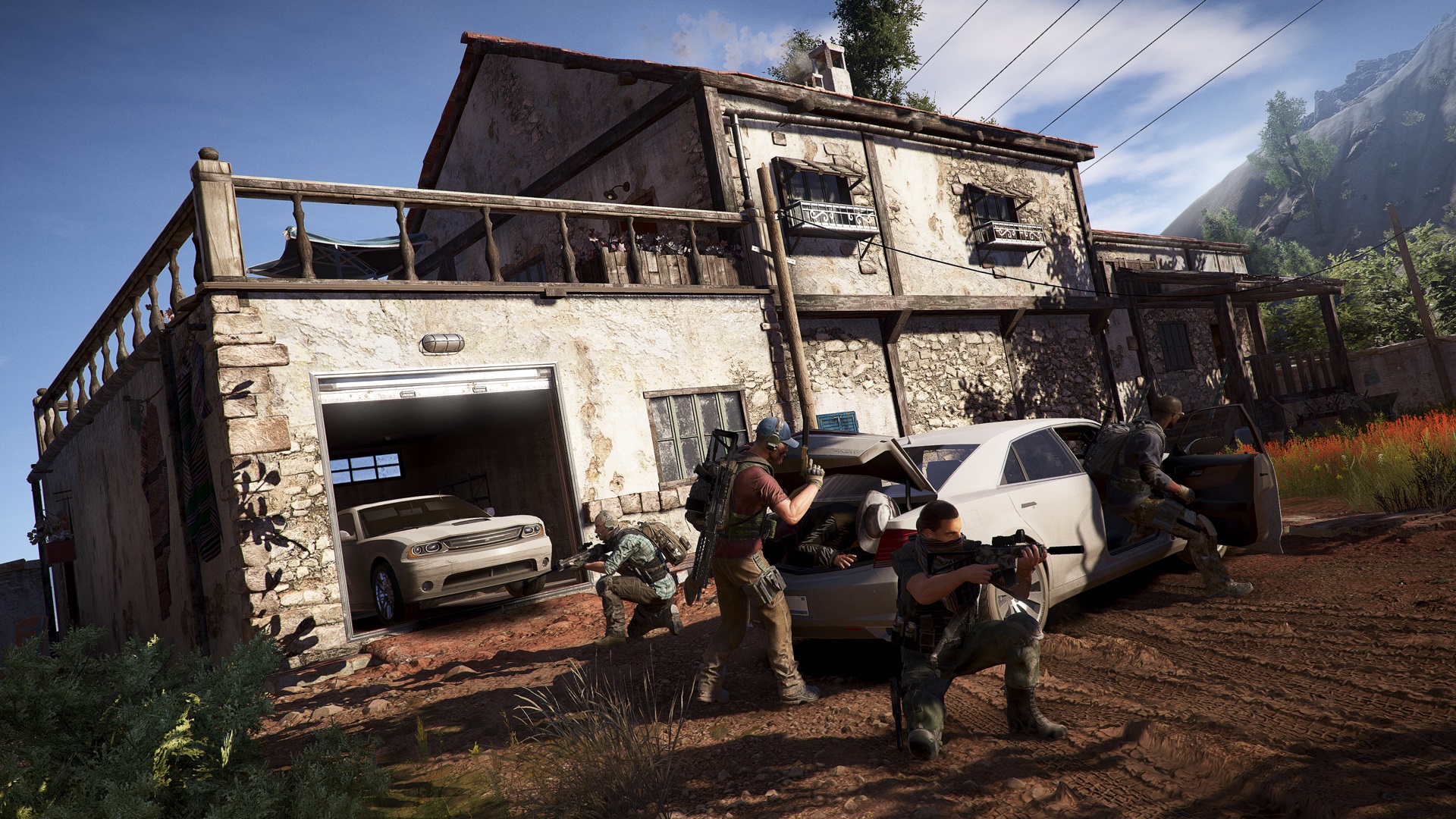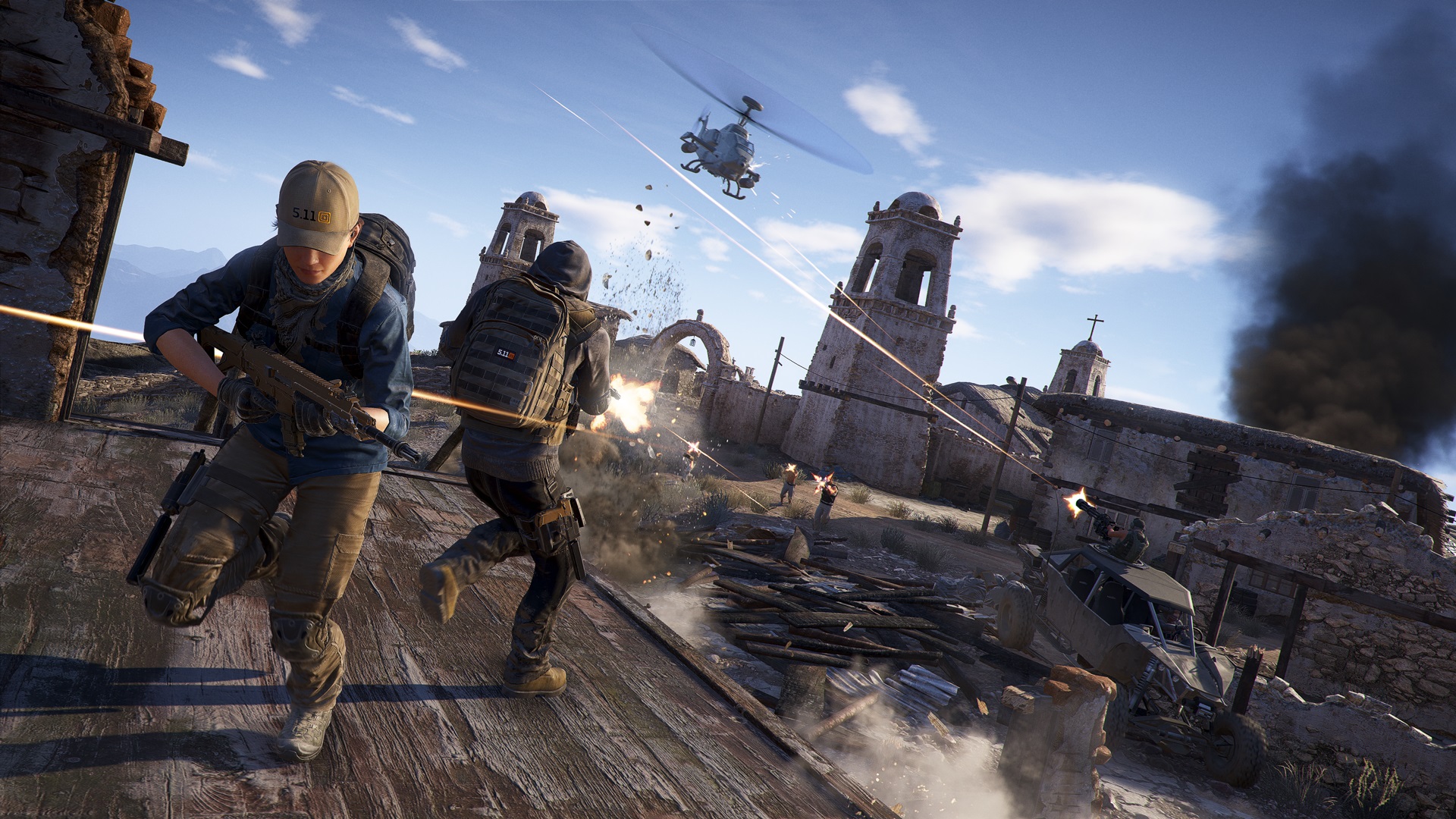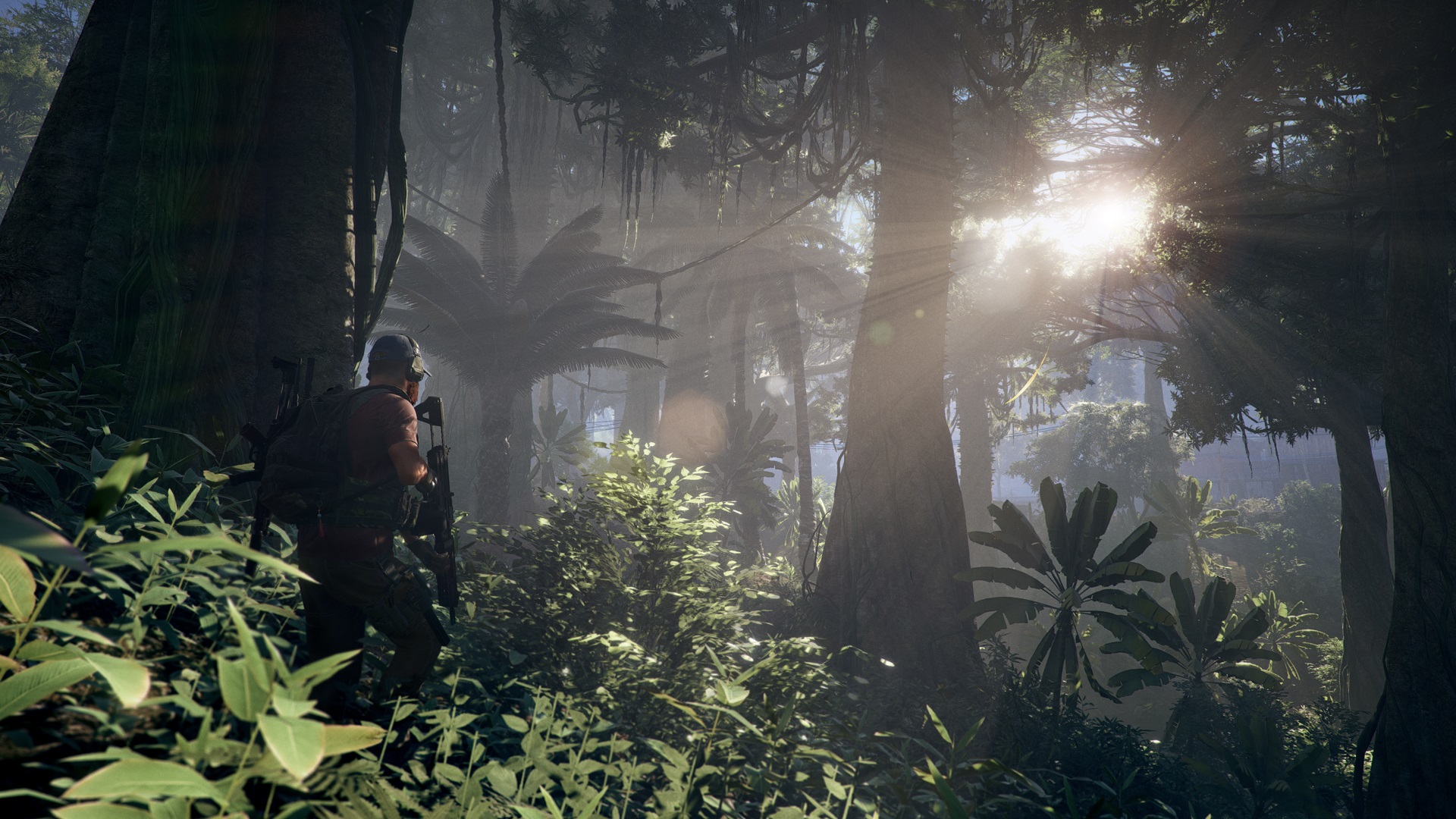'Ghost Recon: Wildlands' Hands On: Taking Down The Cartel
Unless you’re counting the multiplayer-focused Ghost Recon Phantoms that came out in 2014 (I don't), there hasn’t been a solid main installation in the franchise since 2012's Ghost Recon: Future Soldier. Fast forward to today, and Ubisoft Paris is tasked with developing the latest entry in the series, titled Ghost Recon: Wildlands. The game marks a first for the series in that it features open-world gameplay instead of a series of levels. To that end, its developers called it Ubisoft’s largest open-world game. I played the game for a few hours last week to see if the title was on par with the claims.
Welcome To Bolivia
As the leader of an elite team of Ghosts, your job is to take down the Santa Blanca drug cartel in Bolivia, which is split into four distinct “pillars”: production, trafficking, security, and influence. Each of these categories has its own boss, and under them are a plethora of lower-level leaders who control a specific province. You’ll have to take on these bosses one by one and eventually work your way up the cartel’s hierarchy. Once all four underbosses are dealt with, all that remains is Santa Blanca’s leader, El Sueño.
However, El Sueño’s empire is massive. According to senior producer Nouredine Abboud, the area of gameplay consists of 21 different regions. To make it even more authentic to the real Bolivia, the areas are made up of different biomes that range from snow-capped mountains to a humid jungle. Abboud mentioned that every area is available to you from the start of the game, so you’re free to travel to any point on the map from the very beginning. Some areas will be more heavily guarded than others, however, but more on that later.
A large game area requires different methods of travel. Abboud’s tagline at the event was, “If you can steal it, you can drive it.” Throughout the session, I drove cars, helicopters, and planes. However, the experience of driving these vehicles wasn’t as authentic as I thought. It felt like I was controlling a toy vehicle instead of the real thing. This was especially the case with the helicopter: At one point, I was chasing a small convoy, and as I got close enough for my teammates to shoot at the vehicles, it became even more difficult to control the helicopter as I dodged enemy fire and avoided tall trees. The same situation also applies to cars, especially on tight turns. Instead of simply braking and then following the curve of the road, I found that it was easier to just pull the handbrake and drift through every tight-angled turn.
Lead Your Team
Driving issues aside, there are many activities available in each province, and you can do them all in a single-player mode where you also control your AI teammates or play a co-op game with up to three friends. You can take out random targets that appear as you drive along the road, extract local rebel leaders who need rescue from cartel imprisonment, or even encounter specific henchmen and intel that will provide you with additional weapon parts, skill points, or supplies (more on this in a bit).
That doesn’t mean that each mission, whether it’s a main story or something off the beaten path, will always be easy. Most of the time, you’re heavily outnumbered, so it’s not a bad idea to take the stealthy approach before engaging the enemy. In order to help you get the lay of the land, you’ll have a few tools at your disposal. You can utilize binoculars to preview the area that you’ll attack in order to mark enemy locations on your map. For a better angle, however, you might prefer to use the drone, which can easily spot foes from high in the air, so long as they’re outside.
In terms of teamwork, you’ll have a small radial menu of commands at your disposal. These include instructions to open fire, regroup, hold position, or move to a specific area. As you rescue more rebel forces, they can help you in the field with reinforcements or even mortar strikes, which you can order from the same command menu. As glad as I was to see tactical commands in a Ghost Recon game again, I was somewhat disappointed by the fact that I had only a handful of directives to use with my team.
Get Tom's Hardware's best news and in-depth reviews, straight to your inbox.
I brought up the fact that I was a fan of the SOCOM: U.S. Navy Seals tactical games that featured an exhaustive list of commands that included the ability for teammates to provide an overwatch cover to protect me from a high vantage point or the simple action of breaching a room with a grenade or flashbang. According to lead game designer Dominic Butler, the reason for the lack of extensive commands is the overall flow of gameplay.
“We didn’t want you to micromanage the guys, so we knew that the game pace wasn’t fast-paced, but it [also] wasn’t...a very specific, coordinated type of action,” he said. “Instead, the way the game flows is a little bit more action-focused, so we wanted to make sure that you’re not stopping all the time to give them directions. Whenever we’re dealing with teammates, we’re going to analyze how involved we want to be with [them], and really what dictates it is the game pace more than anything else, because the game requires you to often be quick as a player. You have to adapt to a changing situation, so having that [intensity] plus having to...give an extensive set of options to those teammates starts to become more of a burden than support.”
What Butler said actually rang true throughout a few scenarios where the enemy spotted me and opened fire. I was more focused on killing the enemy than issuing commands. Fortunately, my teammates adapted to the situation. If I went in guns blazing, they’d follow suit. The same goes for stealth movements. They didn’t fire unless I specifically told them to do so.
One example of this is the Sync Shot technique where you mark an enemy for one of your teammates to shoot. By holding down a button or shooting another foe, you can set up a synchronized maneuver that can take out up to four enemies at once without alerting the guards. The overall result is near-perfect synchronization with your teammates. They’ll follow you wherever you go, and the simple commands actually help throughout the mission. I just wish that there was more flexibility in what you could tell them to do in order to make it a little more realistic.
Acquire Skills, Take Down Enemies
Even though these Ghosts are already at the top of their class, there is a progression system available throughout the game. This comes in the form of skill points and supplies, both of which are required to acquire and improve skills. These abilities range from access to rebel assistance and an increased number of Sync Shot targets available (you start with only one, but you can upgrade it to allow up to three targets at once), to improved weapons handling or an increased range for your drone. These supplies and skill points are littered all over the map, and you’ll have to gather the correct amount of both groups to advance a specific skill.
In addition, there are multiple crates full of weapon parts scattered all over the Bolivian landscape. This will allow you to acquire new attachments for existing weapons in your inventory, or even acquire a new firearm entirely just by picking up an enemy’s gun. A quick look at the Gunsmith section of the menu reveals that you can change multiple parts of the gun such as the magazine, scope, muzzle, and even the stock. Each part will change some of the gun’s statistics, so it’s best to choose something that will help you out in the field. One piece of advice: It’s best to equip a suppressor for a stealthy approach, and you can always take it off with the push of a button to inflict extra damage.
The ability to travel anywhere on the map at any time in the game is a welcome change, but Butler said that the starting position at the very beginning of the game provides a natural form of progression in terms of enemy strength. Itacua, the initial province where I started my demo, is one of the first provinces you encounter in the game, and the enemy numbers there are small enough that you get an idea of how to use your team effectively to complete each mission.
However, other provinces might have larger and even stronger forces. The Unidad, the Bolivian army that is also in conflict with the cartel, holds a few key locations, and you’ll need stronger firepower and top-notch teamwork to take out these heavily-armed soldiers. However, you can use that overwhelming strength to your advantage. Because they’re unaware of your presence in the region, they will perceive you as an enemy, and Butler said that you can attract Unidad forces to your position if you’re causing trouble in their area. If you lure them to a spot where there are many cartel soldiers, the army will fire at them first, which makes your job a little easier.
Overall, I enjoyed the solo play. The number of games that utilize tactical commands has dwindled over the years, devolving into basic, everyday shooters. Having a team at your disposal makes you think about your actions, and with the commands available to you, you can spend hours and hours carefully infiltrating every outpost or mowing down groups of enemies with coordinated yet lethal attacks. I just wish that there were more available commands.
A Human Fireteam
As fun as it was to play with AI teammates, the real star of the show was co-op gameplay. Halfway through the five-hour demo, we switched from solo play to a four-player team. Even though I didn’t know any of my teammates personally, we were still able to work together and accomplish a few missions.
The switch from solo to co-op gameplay wasn’t drastically different. In fact, one of the main features of the game is that it features drop in/out co-op so your friends can join or leave your session at any time, and you’ll still progress through the game. Because you can go to any province at any time during the game, you and your team can pick any available mission.
We approached our first two missions in an aggressive fashion. With all of us in one pickup truck, we ran into the base head-on and then took out each enemy as they appeared. Somehow, none of us were severely injured in the process, but it did take longer than expected to finish each encounter because we were running all over the base to clear each room. We tried the same aggressive tactic in a mission where we had to capture an enemy target, but we failed it multiple times on account of one of us accidentally shooting the target.
Eventually, we decided to give it the stealthy approach. While a fellow player was marking enemy positions with their drone, I was taking out the snipers that posed a threat to my other two teammates, who would secure the target and leave in our getaway vehicle. Eventually, additional reinforcements arrived, and we were forced to go on the offensive.
The two players that kidnapped the target fled the scene and headed for the objective, while another teammate and I were left behind to deal with the other cartel soldiers. Still, we managed to take them out, catch up with the other half of our team, and complete the objective. It was a stealthy 15 minutes followed by another 15 minutes of intense action, which culminated in the successful, yet sloppy, end to the mission (i.e., we were mistakenly left behind, yet somehow survived).
Later on, we tried another outpost where two players infiltrated the base while another player and I kept watch from afar for any potential enemy threats. However, we ran out of time to finish the mission because the preview event was drawing to a close.
Still, co-op was the more exciting of the two game modes simply because of the team interactions. Sure, your AI teammates will have conversations throughout the game, and you can direct them to perform specific actions, but it’s not the same as having actual people play with you. You can make specific plans on how to take on a group of enemies, stage intricate infiltration tactics and ensure stealth throughout the mission, or figure out how to breach a room like a SWAT team. Teamwork is paramount to success in Ghost Recon: Wildlands, and the best way to do it is with other humans.
What's Next?
I’ve recently returned to playing The Division (another title under the Tom Clancy moniker), and even though both games are under the same company umbrella and even share a few gameplay mechanics, in some ways they couldn’t be more different. Whereas The Division is a more action-focused game, which takes the gear you use as a measurement of your overall strength, Ghost Recon: Wildlands relies more on your skill and ability to use your team to determine your success and failure in each mission. There’s also the complete omission of player-versus-player combat in Ghost Recon: Wildlands, which might turn a few fans away, but I’m content with the fact that I don’t have to compete with other players in this large environment.
As excited as I am to return to Bolivia and use my AI team (or my group of friends) to take down the Santa Blanca cartel, the entire experience left me wondering about the latter parts of the game. As the cartel infrastructure crumbles due to my actions, and El Sueño is the last remaining member of Santa Blanca, what do I do then? Is there anything to do afterwards, or does the story, and more importantly the gameplay, end there? I sincerely hope that isn’t the case, because the open world of Bolivia is massive, and it would be a shame to have noting else to do within it after all that hard work.
| Name | Ghost Recon: Wildlands |
|---|---|
| Type | Open-world, Shooter, Tactical |
| Developer | Ubisoft Paris |
| Publisher | Ubisoft |
| Platforms | PC, Xbox One, PlayStation 4 |
| Where To Buy | Uplay ShopSteamPlayStation StoreXbox StoreAmazonBest BuyTargetWalmartGameStop |
| Release Date | March 7, 2017 |
Rexly Peñaflorida is a freelance writer for Tom's Hardware covering topics such as computer hardware, video games, and general technology news.
-
kwc813 Finally..a single player campaign. If everyone hasn't written off Ubisoft yet this could be a LARGE entry back in to the good graces of many.Reply -
mac_angel I really wish they'd make these games at least have an option of playing it in First person shooting mode (full time, not just while zooming) Some great games out, but I can't stand playing shooter games in third person view.Reply -
K-beam Reply19214772 said:I really wish they'd make these games at least have an option of playing it in First person shooting mode (full time, not just while zooming) Some great games out, but I can't stand playing shooter games in third person view.
Yes, I am a fan of the Ghost Recon franchise since the original game and the 2 expansions and numerous mods. For the Advanced Warfighter and GRAW2 they actually created a totally different game for PC that I still play to date. It went console-y since then, unfortunately. -
TheSpiral01 I feel like the division was a beta for this game and this game is a beta for the next real game from Ubisoft, Splinter Cell!Reply -
stoned_ritual This looks like a recycled version of the division with some splinter cell blacklist assets sprinkled in. No thanks. Boring.Reply



